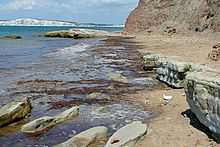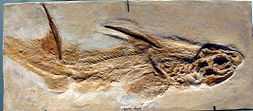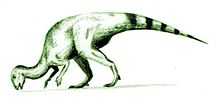Wessex Formation
| Wessex Formation Stratigraphic range: Barremian, 130–126Ma | |
|---|---|
 The Undercliff near Shalcombe, Isle of Wight | |
| Type | Geological formation |
| Unit of | Wealden Group |
| Underlies | Vectis Formation |
| Overlies | Lower Wealden Clay Formation |
| Location | |
| Region | England |
| Country |
|
The Wessex Formation is a fossil-rich English geological formation that dates to the Barremian stage (about 130 million years ago) of the Early Cretaceous. It is part of the Wealden Group and underlies the younger Vectis Formation.
 Geological map of southeast England (Horace B. Woodward, 1904) (for index of colours see London basin map) |
Fauna
Color key
|
Notes Uncertain or tentative taxa are in small text; |
Invertebrates
Invertebrates are commonly preserved in the Wessex Formation. Freshwater bivalves can be found including unionoids such as Margaritifera, Nippononaia, and Unio. These bivalves are helpful in reconstructing what the freshwater paleoenvironment may have been like during the formation's deposition. Specimens of Viviparus, a genus of freshwater snail, have also been found. Cretamygale chasei, a species of Mygalomorph spider, has been described from a specimen found in amber. It is believed to be the oldest known Nemesiid and the second oldest Mygalomorph.[1]
Cartilaginous fishes
| Cartilaginous fishes of the Wessex Formation | ||||||
|---|---|---|---|---|---|---|
| Genus | Species | Location | Stratigraphic Position | Abundance | Note | Images |
|
H. basanus |
 Hybodus | |||||
|
Hylaeobatis |
H. problematica |
|||||
|
Palaeoscyllium |
Indeterminate |
|||||
|
Vectiselachos |
V. ornatus |
|||||
Ray-finned fish
| Ray-finned fishes of the Wessex Formation | ||||||
|---|---|---|---|---|---|---|
| Genus | Species | Location | Stratigraphic Position | Abundance | Notes | Images |
|
Indeterminate |
 Coelodus | |||||
|
Indeterminate |
||||||
|
Indeterminate |
||||||
Turtles
| Turtles of the Wessex Formation | ||||||
|---|---|---|---|---|---|---|
| Genus | Species | Location | Stratigraphic Position | Abundance | Notes | |
|
Helochelydra |
H. nopcsai |
|||||
|
Brodiechelys |
B. brodiei |
|||||
Crurotarsans
| Crurotarsans of the Wessex Formation | ||||||
|---|---|---|---|---|---|---|
| Genus | Species | Location | Stratigraphic Position | Abundance | Notes | Images |
|
A. hooleyi[2] |
||||||
|
H. vectiana |
||||||
|
K. aprosdokiti[3] |
||||||
|
L. brookensis[2] |
||||||
|
V. leptognathus |
||||||
Pterosaurs
| Pterosaurs of the Wessex Formation | ||||||
|---|---|---|---|---|---|---|
| Genus | Species | Location | Stratigraphic Position | Abundance | Notes | Images |
|
C. trimicrodon |
 Caulkicephalus | |||||
|
I. latidens |
||||||
|
Indeterminate |
||||||
|
"Ornithodesmus" |
"O." latidens |
Reclassified as Istiodactylus latidens | ||||
Dinosaurs
Ornithischians
| Ornithischians reported from the Wessex Formation | ||||||
|---|---|---|---|---|---|---|
| Genus | Species | Location | Stratigraphic Position | Material | Notes | Images |
|
D. bampingi |
Junior synonym of Mantellisaurus atherfieldensis |
 Hypsilophodon foxii | ||||
|
H. foxii |
||||||
|
I. seelyi |
Junior synonym of Iguanodon bernissartensis | |||||
|
I. bernissartensis |
Specimens classified as Iguanodon seelyi are referable to this species | |||||
|
M. atherfieldensis |
||||||
|
P. ponderosus |
"Tibia."[4] |
|||||
|
P. foxii |
||||||
|
P. rudgwickensis |
||||||
|
V. canaliculatus |
||||||
Sauropods
Indeterminate diplodicoid and rebbachisaurid remains are known from the formation.
| Sauropods reported from the Wessex Formation | |||||||
|---|---|---|---|---|---|---|---|
| Genus | Species | Location | Stratigraphic Position | Material | Notes | Images | |
|
C. gigas |
"Several cervical vertebrae."[5] |
||||||
|
E. foxi |
"Dorsal vertebra."[5] |
||||||
|
I. valdensis |
"Several caudal vertebrae."[5] |
||||||
|
O. armatus |
"Tooth."[6] |
||||||
|
O. eucamerotus |
"Ischia and pubis."[5] |
||||||
|
O. hulkei |
One dorsal vertebra.[7] |
||||||
Theropods
Indeterminate velociraptorine remains have been recovered from the Wessex Formation.
| Theropods reported from the Wessex Formation | ||||||
|---|---|---|---|---|---|---|
| Genus | Species | Location | Stratigraphic Position | Material | Notes | Images |
|
A. pussilis |
"Sacrum and pubes."[8] |
 Baryonyx walkeri  Neovenator salterii | ||||
|
B. walkeri |
Isolated teeth |
A spinosaurid possibly synonymous with Suchosaurus cultridens | ||||
|
C. foxi |
"Vertebrae."[9] |
A compsognathid | ||||
|
C. oweni |
"Vertebrae."[9] |
A possible oviraptorosaur | ||||
|
E. lengi |
"Partial skull and skeleton."[10] |
|||||
|
N. salerii |
"Partial skull and skeleton."[11] |
A carcharodontosaurian | ||||
|
O. cluniculus |
A dubious species of dromaeosaurid, once misidentified as a pterosaur | |||||
|
T. daviesi |
"Cervical vertebrae."[12] |
A coelurosaur of uncertain classification | ||||
|
"Thecospondylus" |
T. daviesi |
Name preoccupied, renamed Thecocoelurus daviesi | ||||
|
Y. bitholus |
A maniraptoran of uncertain classification, originally identified as an ornithischian | |||||
See also
- List of fossil sites
- List of stratigraphic units with dinosaur body fossils
- Dinosaurs of the Isle of Wight
References
- ↑ Selden, Paul A. (2003). First British Mesozoic Spider, From Cretaceous Amber Of The Isle Of Wight, Southern England. Palaeontology 45(5): 973-983
- ↑ 2.0 2.1 2.2 2.3 Steven W. Salisbury and Darren Naish (2011). "Crocodilians". In Batten, D. J. (eds). English Wealden Fossils. The Palaeontological Association (London). pp. 305–369.
- ↑ 3.0 3.1 Sweetman, S.C., Pedreira-Segade, U., and Vidovic, S.U. 2014. A new bernissartiid crocodyliform from the Lower Cre- taceous Wessex Formation (Wealden Group, Barremian) of the Isle of Wight, southern England. Acta Palaeontologica Polonica. http://www.app.pan.pl/archive/published/app59/app000382013_acc.pdf
- ↑ "Table 17.1," in Weishampel, et al. (2004). Page 368.
- ↑ 5.0 5.1 5.2 5.3 "Table 13.1," in Weishampel, et al. (2004). Page 271.
- ↑ "Table 13.1," in Weishampel, et al. (2004). Page 261.
- ↑ "Table 13.1," in Weishampel, et al. (2004). Page 266.
- ↑ "Table 4.1," in Weishampel, et al. (2004). Page 76.
- ↑ 9.0 9.1 "Table 4.1," in Weishampel, et al. (2004). Page 78.
- ↑ "Table 5.1," in Weishampel, et al. (2004). Page 112.
- ↑ "Table 4.1," in Weishampel, et al. (2004). Page 75.
- ↑ "Table 8.1," in Weishampel, et al. (2004). Page 167.
- Batten, D. J. (ed.) 2011. English Wealden Fossils. The Palaeontological Association, London.